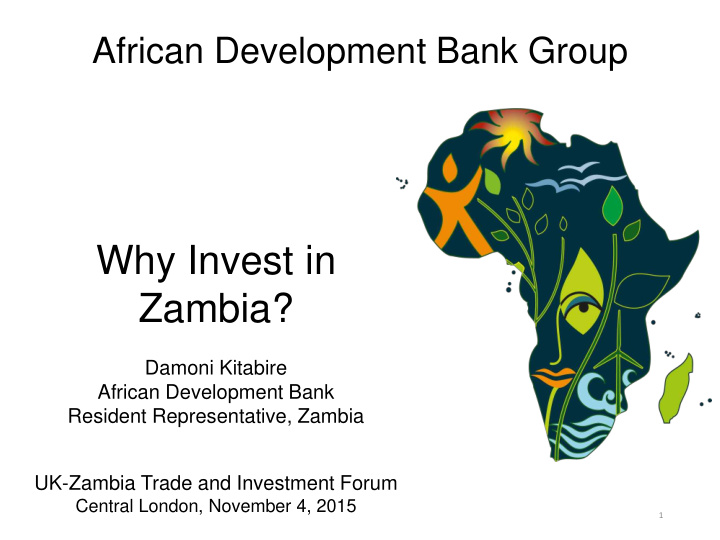



African Development Bank Group Why Invest in Zambia? Damoni Kitabire African Development Bank Resident Representative, Zambia UK-Zambia Trade and Investment Forum Central London, November 4, 2015 1
TH THE AFRICAN DEVELOPMENT BANK – WHO WE ARE: • Established in 1964 • 54 African Member Countries and 24 non-regional members • Concessional and non-concessional lending to Governments • Lending to private sector through commercial banks, equity funds, guarantees and insurance • Private Developmental Projects can be supported directly 2
TH THE AFRICAN DEVELOPMENT BANK – WHO ARE WE: (C (Continued) • Our Strategy focus for the continent is: Infrastructure Development; Regional Integration; Private Sector Development; Governance & Accountability; Skills & Technology 3
ZAMBIA ECONOMIC TR TRENDS • Growing Economy – in excess of 7% during 2001-2010 • Slowing in recent years 4.6% in 2015 (mining slowing and electricity supply deficit affecting production) • Key sectors: Wholesale and Retail Trading (18.5% of GDP), Construction (13.1%), Transport and Communication (10%), Mining (10%) 4
ZAMBIA ECONOMIC TR TRENDS (C (Contin inued) d) • Commodities crunch, falling copper prices (USD 10,000 to USD 5,300 per ton) • Inflation stable around 6-8% during past 4 years, but recent depreciation of Kwacha by almost 50% to the US-Dollar adding pressure on prices. 5
ZAMBIA ECONOMIC TR TRENDS (C (Contin inued) d) • Foreign Direct Investments growing – USD 2.1 billion (2013) – 66% in Mining, 21% in Manufacturing, 9% in Financial Services, • Growing Trade – increasing non-copper exports (cement, gemstones, agri-products, copper wire) Exports – USD 10.2 billion (2014) Imports – USD 8.6 billion (2014) • Reserves 3.7 months of imports (target 4 months) 6
CHALLENGES – CURRENT STATE OF PLAY • Fiscal Deficit (6.9% of GDP, 2015) – large investments in infrastructure (roads) partly to blame • Infrastructure Deficit leading to higher costs and stifling growth Electricity supply is in significant deficit – hydro dependence on the Zambezi/Kafue Basin 7
CHALLENGES – CURRENT STATE OF PLAY (c (conti tinued) Roads – corridors are more or less in place / now need to link rural production with urban consumption Rail – under investment Water availability in some urban areas (affecting industry) 8
CHALLENGES – CURRENT STATE OF PLAY ( Co Contin inued) • High Dependency on Copper – vulnerable to commodity shocks Diversification and Transformation of the economy urgently needed • Low Productivity of skills – often a mismatch of skills supplied and skills demanded /labor regulations 9
OPPORTUNITIES – WHY IN INVEST IN IN ZAMBIA? • Peace and Stability for more than 50 years • Strategic Geographic Position with access to neighboring countries • Macro-stability and a growing consumer market – domestically and regionally Some current macro economic issues Food demand is growing (agro-business), construction materials (many are still imported), forestry products, alternative energy needs, 10
OPPORTUNITIES – WHY IN INVEST IN IN ZAMBIA? (Co (Continued) • Robust Financial Sector offers opportunities for further development, more competition needed. • Opportunities in renewable energy and hydro in the North-East of the country 11
BANK PORTFOLIO – WHAT WE DO IN IN ZAMBIA • Country Strategy (infrastructure and Private Sector ) • Invested more than USD 1.5 bill. Current portfolio USD 890 mill. • Continue to support Government in Infrastructure Development (80% of what we do) • Support Agriculture (value chains – Cassava and Cashew), • Skills and Entrepreneurship • Private Sector (Lines of Credit to local banks) 12
BANK PORTFOLIO – WHAT WE DO IN IN ZAMBIA (Co (Contin inued) • Possibility of providing Corporate Loans • Large transitional projects – e.g. 2400 MW Batoka Dam (lead arranger) • Insurance Type Products: Partial Risk Guarantees (e.g. power purchasing agreements) Partial Credit Guarantees 13
Than ank You 14
Recommend
More recommend